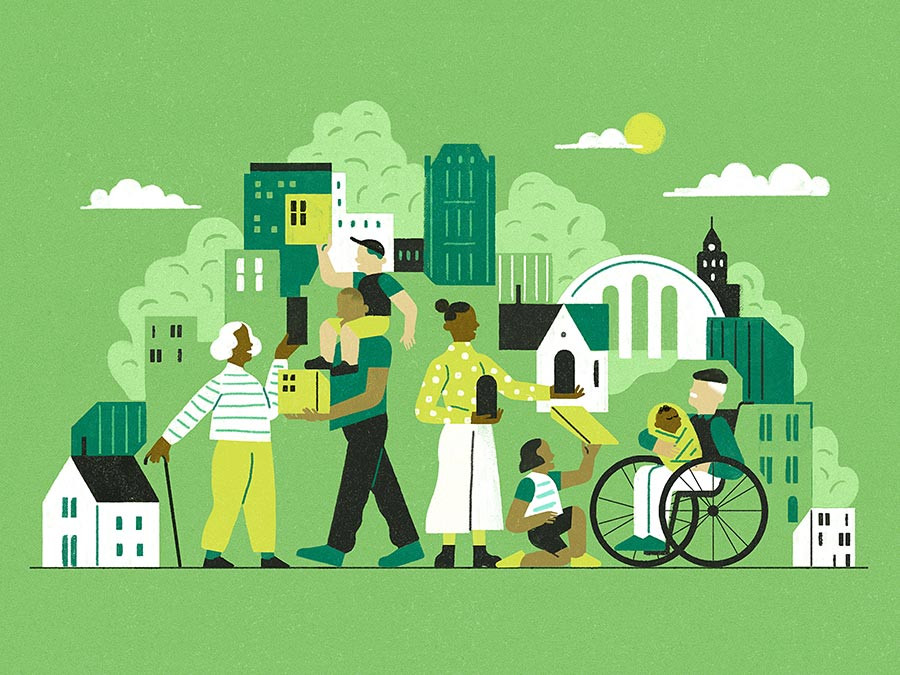 (Illustration by Gracia Lam)
(Illustration by Gracia Lam)
In 19th century America, every major aspect of daily life was age integrated. Older and younger people worked side by side in the fields of an agrarian economy. Multigenerational households were the norm. Even those one-room schoolhouses of yore frequently found children and adults learning to read together under the same roof. Indeed, there was little awareness of age itself. People didn’t celebrate birthdays. Most would be hard-pressed even to recall how old they were.
But in the early decades of the 20th century, the drive for efficiency and standardization that accompanied industrialization precipitated a radical reshuffling of American life. A new set of laws and institutions began putting young people together with young people, and older people together with other older people. Gradually the generational twains ceased to meet, and by the end of the 20th century, America had come to approximate what economics professor Andrew Scott, co-author of The 100-Year Life, describes as a state of "age apartheid."

This separation by age has left us ill-equipped for today’s world, where people are living longer and society is increasingly multigenerational. It has contributed to widespread social issues like ageism, generational enmity, and loneliness. Just as troubling, we’re missing out on the many opportunities for individuals to support one another, and bring the talents of young and old to the task of improving life for all.
With more Americans over 60 than under 18 for the first time in US history, it’s time to reverse this situation in ways that both blunt the ills of age segregation and better realize the benefits of intergenerational interdependence.
The Perils of Age-Segregated Innovation
It’s important to note that restructuring society by age in the 20th century was hardly the result of a nefarious plot to keep generations apart. Rather, it was driven by well-intentioned public policies and social innovations aimed at achieving greater efficiency and solving major problems. New universal education and child labor laws, for example, led to schools putting same-age students together in classrooms. Social Security and mandatory retirement helped dislodge older employees from the workforce in the midst of high Depression-era unemployment. Measures like these ultimately contributed to the age segregation of older adults.
Consider the invention of retirement communities. As life length and the number of retired people dramatically increased mid-century, a “purpose gap” emerged. Older people, increasingly pushed to the margins of society, became a pariah population. In 1949, United Auto Workers President Walter Reuther characterized the growing number of retirees as “too old to work, too young to die.” Seven years later, the architecture critic Lewis Mumford decried the situation in an essay for Architectural Record, writing: “Probably at no period and in no culture have the old ever been so completely rejected as in our own country. ... [T]he aged find their lives progressively meaningless and empty while their days ironically lengthen."
Mumford recommended an ethos of purpose that would help people resist decades defined by leisure pursuits, television, and a vision of “graying as playing.” Most important, he urged generational proximity and the engagement of older people in mainstream life. His essay’s title: "For Older People: Not Segregation but Integration."
The same year Mumford's injunction appeared, a social innovator named Benjamin Schleifer was in the midst of establishing the first age-segregated retirement community in America. Appalled at the isolation of an elderly friend and so many other elderly people, Schleifer wanted to create a community where older people of modest means could escape societal scorn and find the company of agemates. The result was Youngtown, a retirement community 20 miles outside Phoenix open only to buyers over 55. No children allowed. At Youngtown, older people could rediscover their youth in a nation obsessed with young people and with little concern for its growing older population. Indeed, the idea of a “second youth” and age segregation went hand in hand: If everyone was old, then no one was old—a youthful illusion perpetuated by the absence of actual young people.
Youngtown was featured widely in the national news and soon served as inspiration for an entrepreneur named Del Webb, who had even bigger dreams. Across the street from Youngtown’s modest cluster of homes, Webb built the first Sun City retirement community in 1960, now home to nearly 40,000 residents.
This mid-century transformation of housing was just one marker in a century-long social reorganization. Brilliant inventors and good intentions created one age-segregated institution after another—preschools, high schools, senior centers, and assisted-living facilities—as the generations increasingly came to inhabit entirely separate spheres.
Coping With the Consequences
For all the immediate problems these social innovations sought to—and often did—alleviate, they collectively helped create a society at odds with what individuals require to thrive. There is abundant evidence from developmental psychology, for example, that the old and the young need each other. As older people move into the latter phases of life, they develop a deep desire to nurture the next generation; meanwhile, the young need nurturing. It’s a reciprocal relationship that traces back to the beginning of human history—and one key to human happiness. After following hundreds of individuals for more than 80 years, the Harvard Study of Adult Development found that people in middle age and beyond who engaged in caring for and developing younger generations were three times as likely to be happy as those who didn’t.
We have thwarted these intergenerational relationships at our own peril. Demographer Richelle Winkler found that age segregation in America is often as deep-seated as racial segregation. Her research showed that old and young are frequently as segregated as Hispanics and non-Hispanic whites. In another US study, about a third of people over 55 reported that they reside in communities primarily made up of same-age peers.
Without proximity, connections don’t form easily across the generations. One study discovered that a mere 6 percent of people over 60 discussed “important matters” with nonfamily members younger than 36. Lack of proximity may also be responsible for increased loneliness, ageism, and misunderstanding. According to a 2018 survey based on the UCLA Loneliness Scale and conducted by Ipsos for the health insurer Cigna, the two loneliest groups in the country are younger people and older ones. Meanwhile, research by Becca Levy at Yale University suggests that the adverse psychological impact of internalized ageism has significant negative physical and mental health effects.
More broadly, as the late developmental psychologist Erik Erikson observed, age segregation deprives people of a sense of the wholeness of life and leaves individuals unprepared to move from one stage of life to another. How do we know how to grow old gracefully when we have little contact with older people? This divide likewise leaves us with too few opportunities for people of different ages to share views, see beyond stereotypes, and work together toward common goals.
Meeting the Multigenerational Moment
As the US population becomes both older and more diverse, the country faces an essential, pragmatic challenge: How do we turn things around in time to not only reduce the problems of age-based disconnection and division, but also tap the immense possibilities of cross-generational connection and collaboration?
Social innovation—the undertaking largely responsible for how we got into this fix in the first place—is an important part of the answer. In short, we need to be as creative in bringing people together across ages as we’ve been about splitting them apart. And we need to do so in ways that replace the age-segregated landscape of daily life with greater proximity and shared purpose.
It’s a daunting task to be sure, but here’s a dose of good news: We don’t have to start from scratch. Singapore, a world leader in this effort, recently spent $3 billion Singaporean dollars (about $2.4 billion US) to turn its city-state of 5.6 million people into a “kampong for all ages”—a village built on a foundation of intergenerational harmony. How? Through a set of common-sense measures like co-locating senior centers and preschools, and building new housing developments around the precept of multigenerational living.
Singapore might be the world’s most ambitious experiment, but it's hardly alone. Led by the nation’s largest child and family welfare agency, Finland is in the midst of an effort to create “community grandparents,” linking unrelated older and younger people in cases where kin are often separated by many miles. In Zimbabwe, the NGO Friendship Bench has trained hundreds of grandmothers to provide social and emotional support to young mothers and others fighting depression. And in Britain, the nonprofit Now Teach is recruiting individuals in their 50s, 60s, and 70s to become math and science teachers in low-income classrooms.
Nowhere is the spirit of intergenerational innovation more vibrant than in the United States. Indeed, many of the measures in Singapore’s plan were inspired by inventions underway in America, including Providence-Mt. Saint Vincent, an assisted living facility in West Seattle with a total of 400 elders and a preschool classroom on each of the building’s four floors. Social entrepreneurs of all ages and working in all sectors are in the midst of creating a wide array of innovations rooted in long-standing patterns of human behavior, yet responsive to the challenges of contemporary life.
Some are tapping the spirit of the sharing economy to reimagine housing, replacing the “youngtowns” of the past with “young-and-old towns.” Others are merging previously age-segregated institutions to create new, age-integrated ones. Still others are combining the unique assets of the generations to create entirely new kinds of value.
A Deeper Look at Challenges and Solutions
This article series brings these promising efforts to the fore. Stories explore the lessons social innovators are learning, the breakthroughs they’re achieving, and the barriers they’re encountering, and thus can help begin to dramatically expand intergenerational solutions to meet the need and the opportunity.
The series is aimed at social innovators interested in meeting the unique challenges of the new demographics, solving problems in creative ways, and forging communities that are more cohesive. It’s also for investors and philanthropists in search of category-crossing solutions—both common-sensical and cutting edge—and for policy makers determined to draw on the diversity of Americans in ways that move the country forward.
In other words, the series seeks to reach all those who believe fresh thinking and new social arrangements hold the potential to make the most of the multigenerational society already upon us.
Support SSIR’s coverage of cross-sector solutions to global challenges.
Help us further the reach of innovative ideas. Donate today.
Read more stories by Marc Freedman & Trent Stamp.

